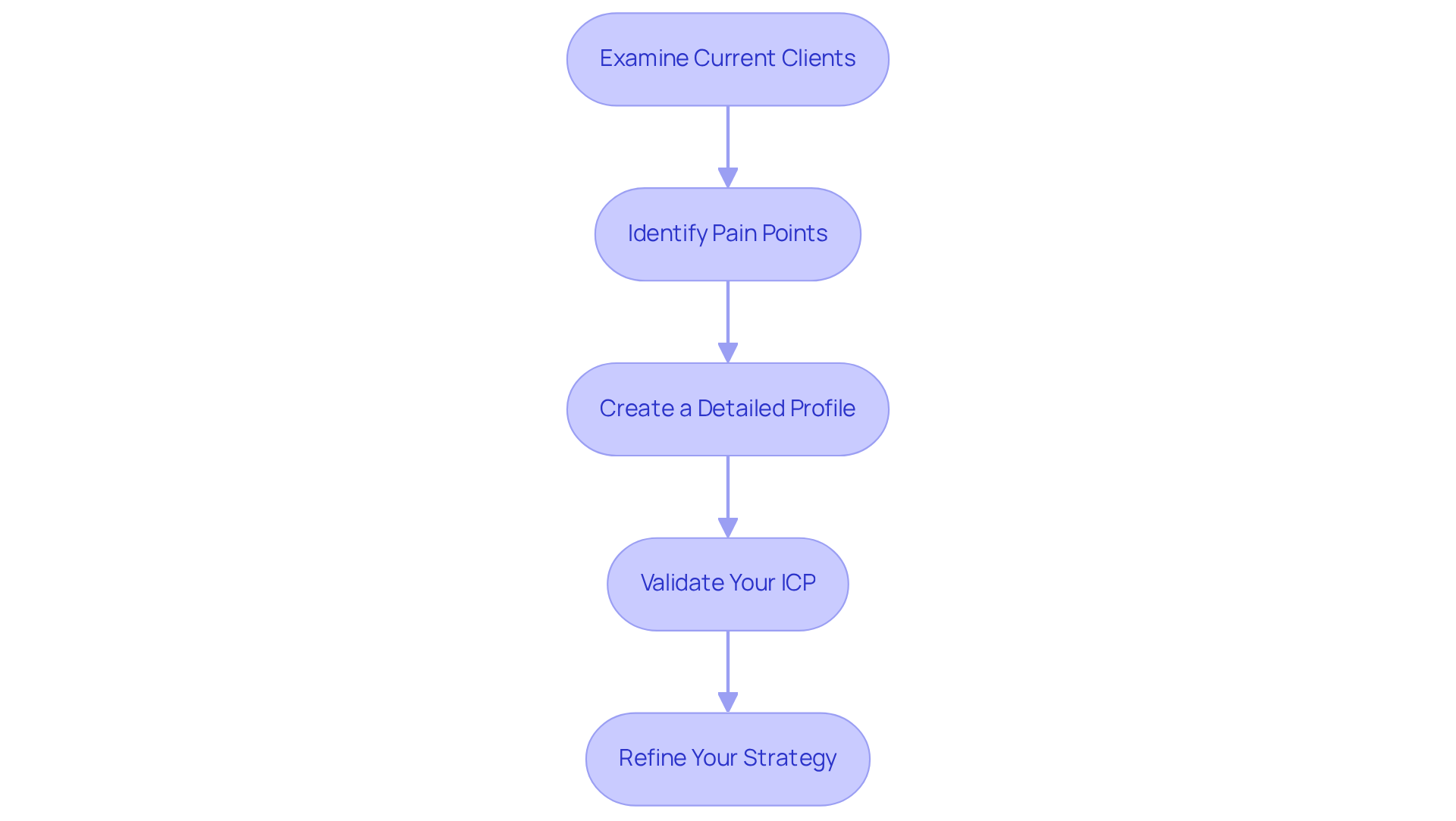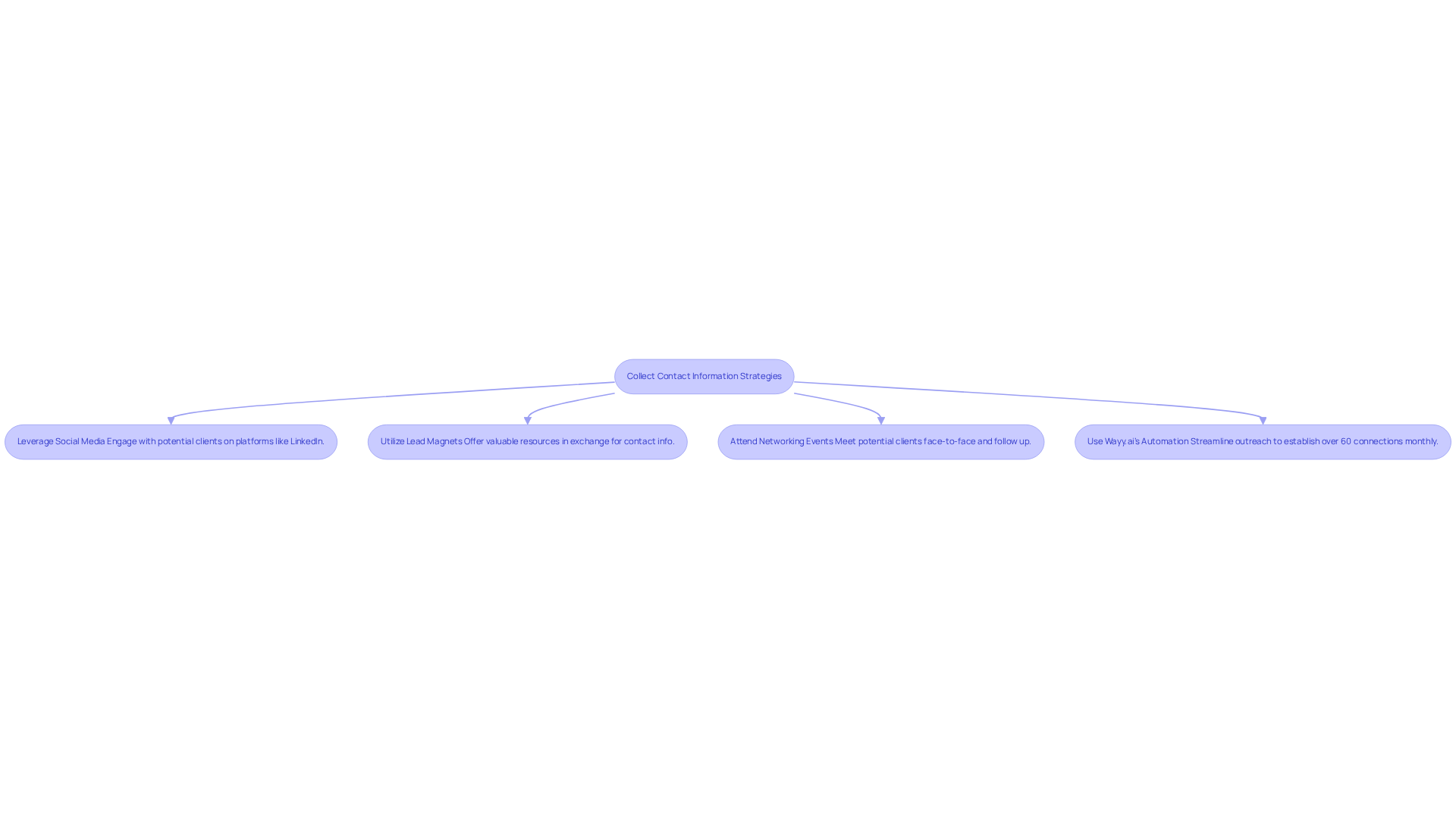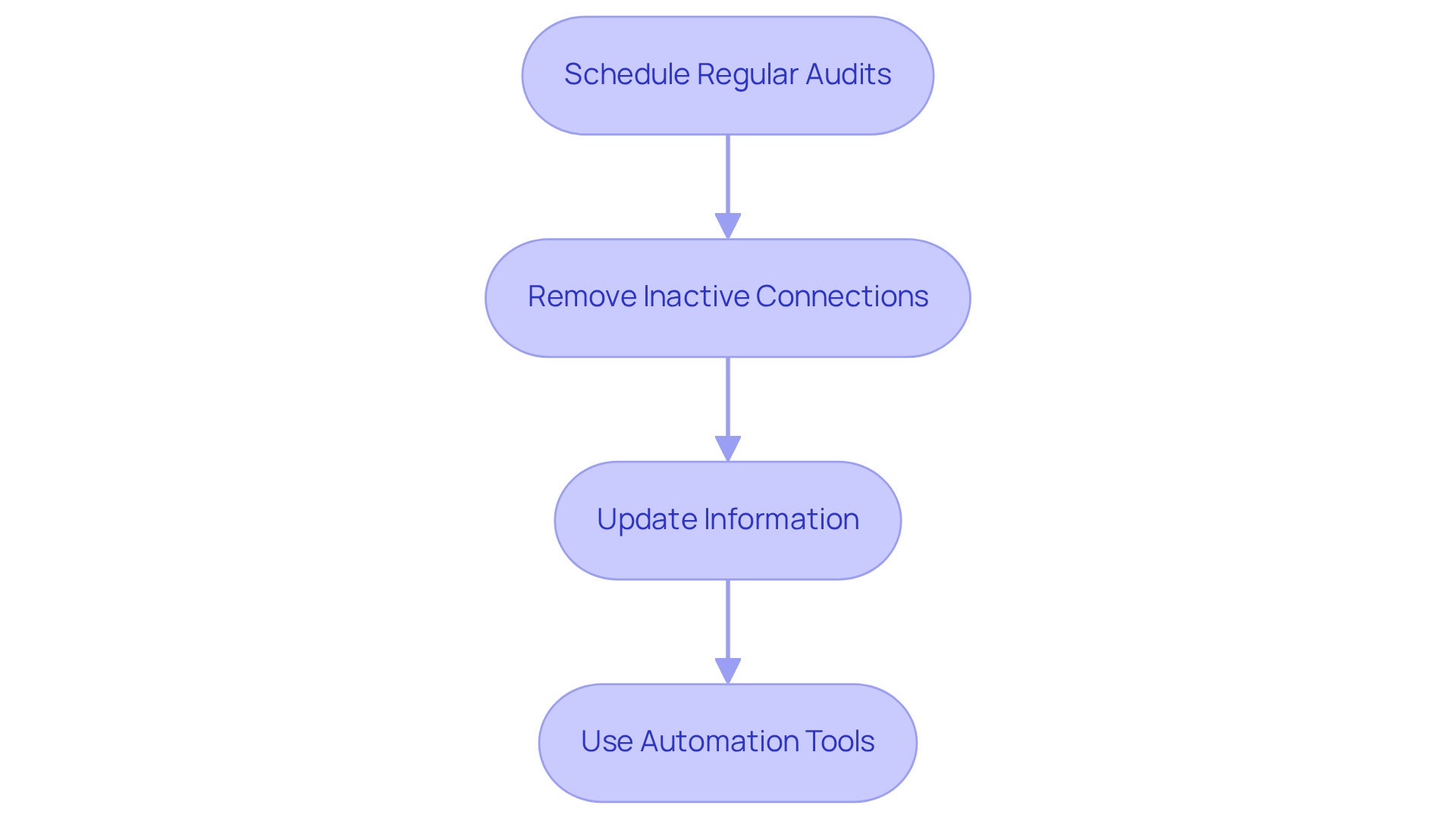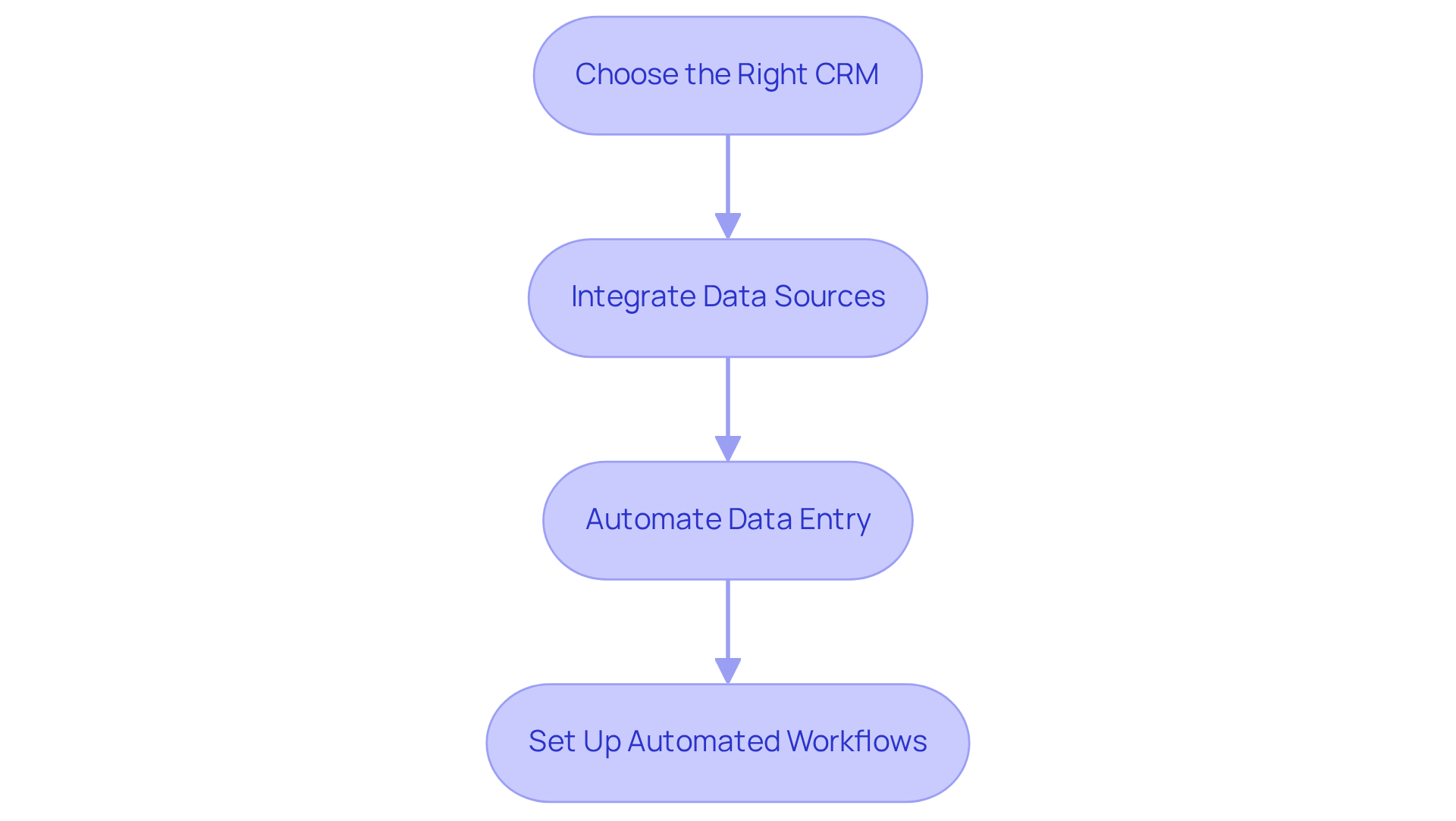Overview
Building effective B2B contact lists can feel daunting for small businesses, but we're here to guide you through four essential steps that can make this process manageable and rewarding.
-
First, it's vital to define your ideal customer profile. Understanding who your clients are will help you tailor your outreach and connect more meaningfully with them.
-
Next, collecting contact information is crucial. Think about the various ways you can gather this data—perhaps through networking events, online forms, or social media. Each touchpoint is an opportunity to build relationships.
-
Once you have your contacts, maintaining and cleaning your list is necessary. Regularly reviewing and updating your information ensures that you engage with the right people, preventing wasted efforts and enhancing your marketing outcomes.
-
Finally, utilizing automation tools can significantly streamline your management process. These tools can help you stay organized, allowing you to focus on what truly matters—nurturing your client relationships.
Remember, understanding client needs and leveraging technology are key to enhancing engagement.
By following these steps, you can create a robust contact list that not only supports your marketing efforts but also fosters genuine connections with your clients. Together, we can navigate these challenges and achieve success in your business journey.
Introduction
Building a robust B2B contact list is not just a task; it's a vital step for small businesses striving to flourish in a competitive landscape. By focusing on their ideal customer profiles and implementing effective strategies for gathering and managing contact information, businesses can unlock new avenues for growth and engagement.
Yet, we understand the challenge: how can small enterprises ensure their outreach efforts are not only efficient but also foster meaningful connections? This guide offers practical steps designed to empower small businesses in cultivating targeted contact lists, streamlining their processes, and enhancing their marketing success.
Together, we can navigate this journey toward achieving your goals.
Define Your Ideal Customer Profile
To define your ideal customer profile (ICP), let’s explore some essential steps together:
- Examine Your Current Clients: Take a moment to review your existing clientele and identify common characteristics among your top clients. What factors stand out—industry, company size, location, or revenue? This analysis can reveal meaningful patterns that highlight what makes your top clients unique.
- Identify Pain Points: Understanding the challenges your target audience faces is crucial. How can your product or service resolve these issues? A recent study shows that 90% of consumers view issue resolution as their most important service concern. By tailoring your messaging to resonate with these pain points, you can significantly enhance your communication effectiveness.
- Create a Detailed Profile: Document the characteristics of your ideal client, including demographics, firmographics, and behavioral traits. This comprehensive profile, combined with your b2b contact lists, will serve as a guiding framework for your marketing strategies and outreach efforts, ensuring you remain aligned with your audience’s needs.
- Validate Your ICP: It’s important to test your assumptions by reaching out to potential clients that fit your profile. Gather feedback from these interactions to refine your ICP further, ensuring it accurately reflects the needs and preferences of your target audience. As Andrew Ng wisely stated, "Your most dissatisfied clients are your greatest source of learning."
By following these steps, small businesses can effectively analyze client traits and develop a targeted strategy for acquiring clients. This approach ultimately leads to improved marketing outcomes and client satisfaction. Remember, Wayy.ai can assist in this process by automating outreach and providing insights into customer behavior, making it easier for small business owners to establish meaningful connections. Together, we can and achieve success.

Collect Contact Information Using Effective Strategies
To effectively collect contact information, consider these compassionate strategies:
- Leverage Social Media: Think of social media as a bridge to connect with potential clients. Platforms like LinkedIn offer a wonderful opportunity to engage with their content. By liking, commenting, and sharing insights, you can build genuine relationships. Then, sending personalized connection requests can foster a sense of community that resonates with your audience.
- Utilize Lead Magnets: Offering valuable resources such as eBooks, webinars, or templates in exchange for contact information can be a game-changer. This method not only provides prospects with something useful but also encourages them to share their information, enhancing your lead generation efforts.
- Attend Networking Events: Participating in industry conferences and trade shows allows you to meet potential clients face-to-face. Collecting business cards is just the beginning; following up with personalized messages can help maintain those connections and show that you genuinely care.
- Use Wayy.ai's Automation: Imagine with Wayy.ai's unique automation features. This platform can assist you in establishing over 60 target client connections each month, ensuring that your marketing campaigns are both efficient and effective. Together, we can achieve success in your outreach endeavors.

Maintain and Clean Your B2B Contact List Regularly
To effectively maintain and clean your B2B contact list, we understand the importance of following best practices that can truly make a difference:
- Schedule Regular Audits: Establish a recurring timetable, ideally every 3 to 6 months, to carefully review your list of connections for accuracy and relevance. This proactive approach ensures your outreach efforts are directed toward engaged prospects. For instance, small businesses like XYZ Corp have successfully implemented quarterly audits, leading to a 20% increase in engagement rates. Imagine what this could mean for your business!
- Remove Inactive Connections: It’s essential to identify and eliminate individuals who haven’t interacted with your communications over a defined period. By focusing on active leads from B2B contact lists, you can enhance your engagement rates, ultimately leading to improved conversion rates. Think of it as clearing out clutter to make way for new opportunities.
- Update Information: Consistently verify and refresh details, including email addresses and job titles. Accurate information is crucial for effective outreach, ensuring your messages reach the right individuals. Regular updates can lead to a more responsive audience and higher engagement, which is what we all strive for.
- Use Automation Tools: Leverage CRM systems or email marketing platforms equipped with list cleaning features. For example, offers automation capabilities that simplify managing your contact list, such as handling bounced emails and detecting duplicates. By utilizing these tools, small business owners can streamline their list management activities, allowing you to concentrate on building meaningful connections with potential clients. Together, we can achieve success in your outreach efforts.

Utilize Automation Tools for Efficient List Management
To effectively utilize automation tools for efficient list management, it’s essential to follow these supportive steps:
- Choose the Right CRM: Begin by selecting a customer relationship management (CRM) system that aligns with your unique business needs. Prioritize features such as audience segmentation, automated follow-ups, and comprehensive reporting. These tools can significantly enhance your outreach efforts, helping you connect with your audience more effectively.
- Integrate Data Sources: Consider connecting your CRM with various platforms, including email marketing tools and social media channels. This integration centralizes your information, ensuring seamless updates and minimizing the risk of data silos. Imagine how much easier it would be to manage your contacts when everything is in one place!
- Automate Data Entry: Implement tools that automatically capture and input details from forms, emails, and social media interactions. This automation reduces manual effort, allowing your team to focus on strategic tasks rather than data entry. After all, people spend 60% to 80% of their time trying to find data, leading to significant productivity loss. By automating this process, you can reclaim valuable time.
- Set Up Automated Workflows: Design workflows that trigger specific actions based on defined criteria. For example, you can automate follow-up emails after an individual is added or update individual statuses based on engagement metrics. This proactive approach not only enhances communication but also nurtures leads effectively. As Prashanth Southekal wisely states, "Success isn’t about data collection; it’s about data management and insight."
By leveraging these automation strategies, small businesses can streamline their contact management processes with b2b contact lists, ultimately leading to improved efficiency and increased sales opportunities. For instance, Wayy.ai has empowered users to establish over 60 target client connections each month without manual effort. This showcases the effectiveness of automation in outreach. Together, we can achieve success and of managing your contacts with confidence.

Conclusion
Building effective B2B contact lists is essential for small businesses looking to enhance their marketing strategies and outreach efforts. By focusing on your ideal customer profile, gathering relevant contact information, and maintaining a clean list, you can create a strong foundation for meaningful client connections. This structured approach not only simplifies the process of acquiring new clients but also boosts engagement and conversion rates, which we know are crucial for your success.
Key insights from this guide highlight the importance of:
- Understanding client characteristics
- Leveraging social media
- Using lead magnets to gather contact information
Regularly maintaining your contact lists through audits and updates ensures that your outreach efforts reach engaged prospects. Additionally, integrating automation tools can simplify list management, allowing you to concentrate on strategic initiatives rather than getting bogged down in administrative tasks.
Ultimately, the importance of building and managing effective B2B contact lists cannot be overstated. We encourage you to adopt these best practices and leverage technology to enhance your outreach and client engagement. By taking proactive steps to define your target audience and maintain your contact lists, you can unlock new opportunities for growth and success in an increasingly competitive market. Together, we can achieve the success you envision for your business.
Frequently Asked Questions
What is an Ideal Customer Profile (ICP)?
An Ideal Customer Profile (ICP) is a detailed description of the characteristics of your ideal client, including demographics, firmographics, and behavioral traits, which serves as a framework for marketing strategies and outreach efforts.
How can I define my Ideal Customer Profile?
To define your ICP, examine your current clients to identify common characteristics, understand the pain points of your target audience, create a detailed profile documenting these traits, and validate your ICP by gathering feedback from potential clients that fit your profile.
Why is it important to identify pain points in my target audience?
Identifying pain points is crucial because understanding the challenges your target audience faces allows you to tailor your messaging to address these issues, significantly enhancing communication effectiveness and customer satisfaction.
What steps should I take to examine my current clients?
Review your existing clientele to identify common characteristics such as industry, company size, location, and revenue. This analysis can reveal meaningful patterns that highlight what makes your top clients unique.
How can I validate my Ideal Customer Profile?
You can validate your ICP by reaching out to potential clients that fit your profile and gathering feedback from these interactions to refine your ICP further, ensuring it accurately reflects the needs and preferences of your target audience.
What role does Wayy.ai play in developing an Ideal Customer Profile?
Wayy.ai can assist in automating outreach and providing insights into customer behavior, making it easier for small business owners to establish meaningful connections and navigate the challenges of client acquisition.




